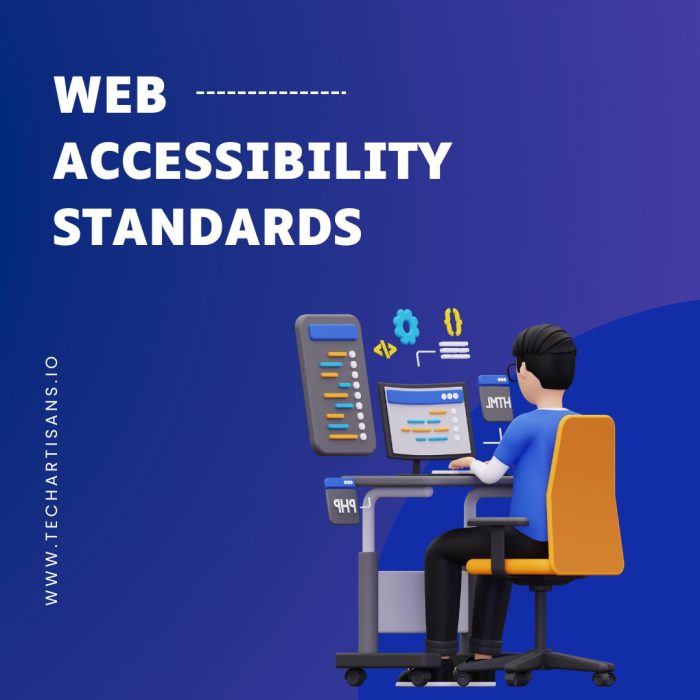In this digital age, the importance of web accessibility cannot be overemphasized. Adhering to the Web Content Accessibility Guidelines (WCAG) is vital for reaching a wider audience and ensuring equal access to your content, particularly for people with disabilities. WCAG sets the standard for making your website usable by everyone, enhancing the user experience, and showing social responsibility. Let’s explore website accessibility and how WCAG can make digital experiences more inclusive.
What is Web Accessibility?
Web Accessibility means making your website easy for everyone, including people with disabilities. It’s about creating a welcoming, inclusive, and user-friendly site for all, regardless of visual, auditory, physical, speech, cognitive, or neurological abilities. It breaks down barriers, providing an equal experience for everyone.
Significance
Website accessibility ensures that everyone can access and use websites effectively. It’s all about providing a universally friendly online experience, allowing people with disabilities to interact with the web easily. This builds inclusivity and benefits businesses by improving SEO, reaching more people, and avoiding legal issues. It’s a vital part of a successful digital strategy, recognizing the internet’s importance in various aspects of life like education, work, government, shopping, health, and leisure.
Overview of WCAG
Developed through the W3C process in cooperation with individuals and organizations worldwide, WCAG provides a comprehensive framework for making web content more accessible to a broader range of people with disabilities.
1. History and Evolution
The WCAG journey started in 1999 with WCAG 1.0, aiming to make the web more accessible. In 2008, WCAG 2.0 came about, providing more detailed guidelines for accessible design. The latest, WCAG 2.2 from 2020, added more requirements to help those with low vision and learning disabilities. It keeps evolving to keep up with digital changes and the increasing importance of web accessibility.
2. Purpose and Global Recognition
WCAG’s main purpose is to offer universal guidelines for making web content accessible to all, including people with disabilities. It’s globally recognized, serving as the gold standard for web accessibility and helping businesses create inclusive digital experiences. Many governments have even legally required businesses to follow these guidelines, highlighting its vital role in creating a more inclusive digital world.
Understanding WCAG Versions
Let’s explore the various versions of WCAG and their distinctive contributions to creating a more inclusive digital world.
1. Differences Between WCAG 2.0, 2.1, and 2.2.
- In 2008, WCAG 2.0 improved upon the previous version with a more adaptable approach and testable design standards.
- In 2018, WCAG 2.1 expanded the guidelines, adding 17 new criteria for mobile and addressing low vision and cognitive issues.
- The latest, WCAG 2.2 from 2020, enhances accessibility for low vision and cognitive disabilities, continuing to refine the guidelines for a more inclusive web experience.
2. Significance of Updates in Modern Web Usage
WCAG updates keep up with changing technology and user interfaces, ensuring inclusivity in the digital world. These refinements help address new accessibility challenges, paving the way for a more inclusive future. Businesses that embrace these changes benefit from a wider audience, better user experience, and a strong reputation for inclusivity.
Core Principles of WCAG
Let’s explore the core principles of WCAG.
1. Perceivable
In web accessibility, the “Perceivable” principle emphasizes that all users should be able to understand the information presented, regardless of how it’s presented. This involves providing text alternatives for non-text content and ensuring that audio and visual content is accessible. It also ensures that content is easy to see and hear, promoting a more inclusive digital experience.
2. Operable
The operable principle ensures that all users can interact with the website. This means all functionality is available from a keyboard, and users have enough time to read and use the content. Furthermore, the website does not use content known to cause seizures, and it provides ways to help users navigate, find content, and determine where they are.
3. Understandable
Following the Understandable principle means the information and website operation are understandable. This implies that text is readable and understandable, pages operate and appear in predictable ways, and assistance is provided to users to avoid and correct mistakes.
4. Robust
Lastly, the Robust principle emphasizes that content must be robust enough to be reliably interpreted by various user agents, including assistive technologies. This means that as technologies advance, the website should remain accessible. It involves ensuring compatibility with current and future tools.
5. Examples of Each Principle
- Perceivable – Real-life example
Consider a news website that offers captions or transcripts for its audio-visual content. Such a feature ensures that users with hearing impairments can perceive and understand the conveyed information. Similarly, alt-text for images ensures visually impaired users can understand the content via screen readers.
- Operable – Real-life example
Regarding web accessibility, e-commerce websites can include keyboard functionality, enabling users with physical disabilities to navigate without a mouse. Additionally, skip navigation links enhance operability, provide quick access to various site sections, and make the website more inclusive and user-friendly.
- Understandable – Real-life example
A banking website that uses clear, simple language avoids technical jargon, making it easier for users with cognitive disabilities to understand the content. Any errors made during form submission are highlighted, helping users rectify them.
- Robust – Real-life example
A blog with strong coding standards remains accessible despite technology advancements. It functions seamlessly with various browsers and is compatible with assistive technologies such as screen readers, ensuring a smooth experience for disabled users.
Practical Steps for Businesses
Let’s explore some practical steps businesses can take to ensure their websites are accessible, aligning with WCAG principles, and fostering an inclusive digital environment.
1. Starting Your Digital Accessibility Journey
Start your journey towards digital accessibility by becoming aware of its importance for your business. Learn about WCAG guidelines and success criteria. Then, audit your website to find non-compliant areas and barriers for disabled users. Finally, make accessibility part of your design and development process, using experts or tools to ensure compliance. Remember, it’s an ongoing commitment to inclusivity, not a one-time job.
2. Role-specific Guidelines
- For Developers
Developers should ensure their code adheres to WCAG standards. This includes using semantic HTML for content structure, ensuring keyboard accessibility, and implementing ARIA (Accessible Rich Internet Applications) where appropriate to enhance the accessibility of dynamic content.
- For Designers
In web accessibility, designers have a crucial role in crafting user-friendly, inclusive interfaces. This includes choosing color contrasts that adhere to WCAG standards, creating clear navigation structures, and addressing the needs of users with various disabilities during the design process.
- For Content Authors
Content authors should make their content easily understandable, using plain language and providing text alternatives for non-text content. Additionally, they should structure content logically, using appropriate headings, lists, and links.
3. Tips and Best Practices
- Consistency: Ensure consistency in your site’s functionality and design to make it easier for all users to understand and navigate.
- Alt Text: Use alt text for images, conveying content and function of the image to visually impaired users.
- Keyboard Navigation: Verify that all site functions are accessible via keyboard for users who can’t use a mouse.
- Multimedia: Provide closed captions for videos and transcripts for audio content to assist hearing-impaired users.
- Color Contrast: Ensure adequate color contrast between the text and its background to aid users with color vision deficiencies.
Guidelines and Success Criteria
Guidelines and Success Criteria are integral to enforcing and maintaining web accessibility standards. These comprehensive guidelines and clearly defined success criteria ensure that websites are navigable and usable for all, promoting digital inclusivity. Let us delve deeper into understanding these guidelines and their associated success criteria.
1. Guidelines For Each POUR Principle
- “Perceivable” means content must be presented in ways users can understand, with text alternatives for non-text content and captions for media.
- “Operable” focuses on user interface and navigation, ensuring content is keyboard-friendly, not seizure-inducing, and easy to navigate.
- “Understandable” guidelines aim for clear content and user interface operation, including readability, predictability, and error prevention.
- “Robust” ensures content works well with various user tools and remains accessible as technology evolves.
2. Understanding Conformance Levels: A, AA, AAA
The WCAG includes three conformance levels, each with specific criteria.
- Level A
The most basic web accessibility features. Websites that do not conform to this level fail to meet many requirements for disabled users and will be difficult to use.
- Level AA
Tackles the most common barriers for disabled users. When sites meet both Level A and Level AA, they provide fair accessibility and solve the most significant issues.
- Level AAA
The highest and most comprehensive level of website accessibility. It is challenging for most websites to satisfy all Level AAA success criteria. Hence, it’s not required as a general policy for entire sites.
3. Importance of Achieving Level AA for Businesses
Meeting Level AA in web accessibility is crucial for businesses, making your site more user-friendly and reaching a broader audience, including those with disabilities. This commitment to inclusivity also improves your brand’s reputation and reduces legal risks. Plus, it enhances the user experience, boosting customer retention and conversions. In short, investing in website accessibility is the right thing to do and has real benefits for your business’s growth and success.
Future of Web Accessibility
The future of website accessibility promises to be an exciting and transformative journey marked by technological advancements and a strengthened commitment to making the digital world inclusive for all.
1. Upcoming Updates in WCAG
The W3C updates WCAG to match users’ diverse needs and evolving tech. WCAG 3.0, called “Silver,” is coming, aiming to be user-friendly and relevant for emerging tech. It will likely introduce a flexible scoring system for detailed accessibility feedback, helping businesses improve and create a more accessible digital world.
2. Increasing Relevance of Accessibility in New Technologies
The advent of new technologies such as AI, VR, and IoT underscores the increasing significance of website accessibility. As digital interfaces become more sophisticated and pervasive, ensuring they are universally accessible is paramount. This broadens user engagement and encourages innovation in inclusivity, leading to a more equitable digital landscape.
Legal Implications of Web Accessibility
Failure to comply with Website Accessibility Standards can have serious legal implications for your business. Let’s delve into how neglecting website accessibility could land your business in legal hot water.
1. Legal Requirements and Non-Compliance Consequences
Website accessibility is not just a suggestion; it’s a legal requirement in many countries, including the U.S. Non-compliance with laws like the ADA and Section 508 can lead to lawsuits and fines, harm your brand’s reputation, and cost you customers. To steer clear of these issues, businesses must make website accessibility a priority.
2. Notable Lawsuits and Outcomes
Two notable cases illustrate the legal consequences of web accessibility violations. Target faced a lawsuit in 2008, paying $6 million for an inaccessible website; Netflix was sued in 2012 for lacking closed captions, leading to a commitment to provide captions for all content. These cases emphasize the importance of maintaining an inclusive online presence to avoid legal troubles.
Conclusion
The importance of web accessibility cannot be overstated. Website accessibility is both an ethical duty and a legal requirement, and it’s smart for business. Following Website Accessibility Standards and WCAG guidelines ensure your digital assets are accessible, inclusive, and user-friendly. This broadens your customer base, boosts your brand’s reputation, and reduces legal risks.







